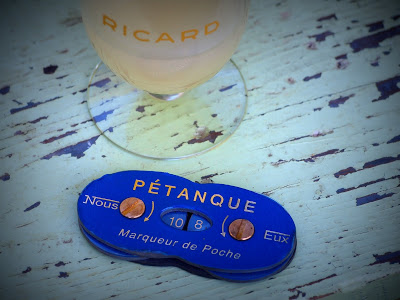
| A glass of Pastis next to a scoring tool for pétanque |
We played pétanque, drank pastis, and spoke a little French last weekend. The only sign that we were in Portsmouth, New Hampshire was the Norwegian Maple tree—a poor substitute for the stately Plane tree that is rarely far from any game of pétanque in Provence—but, it didn’t matter. Palm trees could have framed the terrain where the games took place. All eyes were on the players and their boules….well, unless they were on the pastis. C’etait formidable!
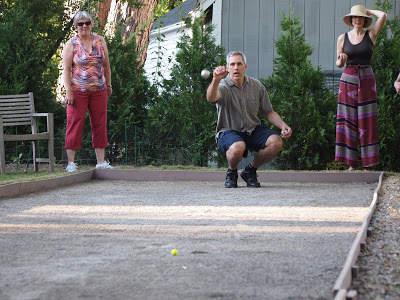 |
| Portsmouth, New Hampshire |
I have watched the game for many years in France, but I’ve never had the opportunity—or I’ve never taken the opportunity—to indulge in this national past time, myself. I had been content to be a spectator. My husband and I have been known to spend hours watching village games. How could watching a few balls being tossed over and over again be so riveting?
 |
| Saignon, Provence |
In Provence, where the game was born, watching pétanque is akin to watching a scene from of a Marcel Pagnol movie. Players typically are charming old men—who’s left in to play during the day in these tiny villages?–who don straw hats and berets as if…
such hatware were an obligatory part of a French national pétanque uniform. There’s intensity among the players that must rival that of surgeons in the operating room. Nothing else matters when a game is in session, as depicted in a famous scene from Pagnol’s 1932 film Fanny.
These seemingly mild-mannered men speak French rapidly with a severe Provencal accent that is usually impossible for even my husband to decipher. When a dispute erupts—usually over the distance between opponents’ boules and the cochonnet—words fly faster than the speed of sound, arms wave, and fingers wag, eclipsing any comprehension by spectators like me except the universal understanding that there is a disagreement seemingly as important as the division of empires in Post-World War II. When the boulomètre à tirette is unfolded, the men squat down, as if on cue, and lean in to watch the man with the measuring device as he precisely assesses in millimeters the distances that are the source of contention.
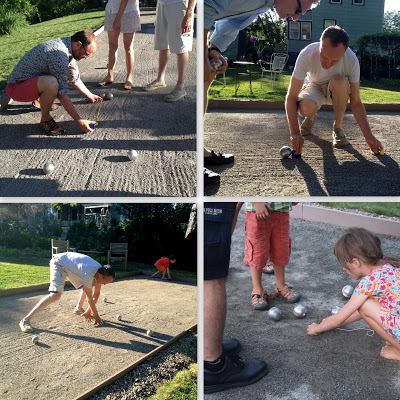 |
| Whose ball is closer to the cochonnet? |
The measurement may or may not settle the dispute but just as quickly as it erupted, laughter replaces accusations, fingers are again wrapped around boules and arms are tossing them toward the cochonnet. My heart rate reverts to normal and I pepper my husband with questions about what just happened. Usually neither of us knows. Mais, pas de problème —if you are lucky enough to be able to while away a sunny afternoon in Provence, few activities could be more pleasant than stopping to rest under a canopy of the region’s majestic plane trees in a small Luberon village and watch this quintessentially French game of boules.
 |
| Saignon, Provence |
Pétanque is a variation of the game of boules, a game that, in one form or another, has been around for centuries. The Romans undoubtedly introduced the modern-day version of boules (in which balls are tossed toward a target) when they came to Provence over 2000 years ago. Basically, a target ball is initially tossed down a long court and opponents—individuals or teams—take turns tossing a ball toward the target with the goal being to get your balls as close to the target as possible by steady aim or knocking your opponent’s balls away from the target ball (otherwise known as the cochonnet).
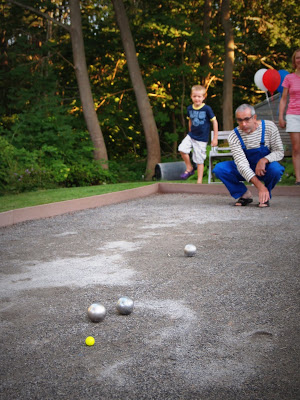 |
| Portsmouth, New Hampshire |
As early as the 19th century, the game came to be known as boules in France (“bowls” or “lawn bowling” in England) and jeu Provençal in Provence. It was further defined at that time by requiring players to run three large steps (or jumps) before tossing a heavy ball on to a court 15 to 20 meters long. It required a certain athleticism.
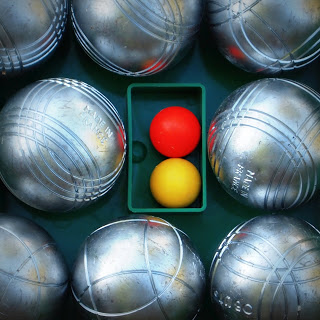 |
| Boules et cochonnets |
In the early 20th century, in June 1907 in La Ciotat, a small coastal town between Marseille and Toulon, when a popular jeu Provencal player, Jules Lenoir, lacked the athleticism to continue to play—his chronic rheumatism made it impossible for him to be able to take the running steps before the throw—his longtime friend and fellow jeu Provencal player, Ernest Pitiot, said that they would play a “shorter” game.
 |
| Portsmouth, New Hampshire |
The “shorter” game would consist of a shorter terrain or court and a stationary toss. From a circle drawn at the end of the terrain, all players would throw their boules—there would be no running start. Rather, feet would be together, on the ground—pès tancats which means, in Occitan, the old Provençal language, “feet together or anchored.” (The origin of the word is also said to be pieds tanqués which, in French, has the same meaning.) In 1910, Ernest and his brother Joseph Pitiot , owners of a café in La Ciotat, organized the first pétanque tournament. Pétanque was born and it quickly became wildly popular. (Attentive viewers will have noted that the clip from Pagnol’s Fanny was actually boules.)
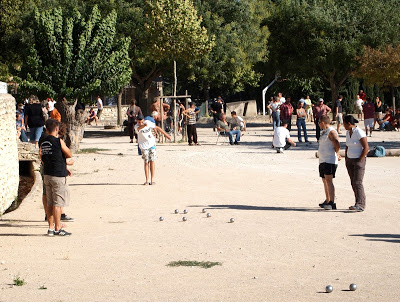 |
| Lourmarin, Provence |
Today pétanque is played by upwards of 17 million people in France and in many other countries, including the United States where there has been a recent surge of enthusiasm for this game, definitely not limited to charming old men.
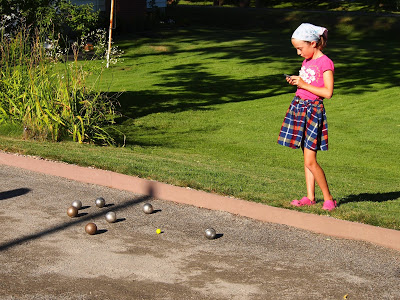 |
| A young scorekeeper |
Back in Portsmouth, Jean-Christophe Barré and his wife Kristina Logan, the hosts of our evening of pétanque, are doing their part to encourage enthusiasm for pétanque (and speaking French!). Jean-Christophe is a French teacher and founded the Active French School in Portsmouth. He is a native French speaker, born and raised in Normandy, who received a master’s degree in French literature and linguistics and a bachelor’s degree in teaching French as a Second Language.
 |
| Jean-Christophe rakes the terrain |
Jean-Christophe has worked for twenty years as a teacher of French in several schools in France, including Créa-Langues, a well-known French language school in Moustiers where I took an excellent week-long immersion class several years ago. Jean-Christophe was not teaching during the session I attended but the other teachers spoke very highly of him and told me that I must look him up when I returned home to Portsmouth. Little did I know that he and his family lived just a few blocks from my home. I am confident his classes are excellent—check out his website for more information about classes, including online classes: www.activefrenchschool.com.
Jean-Christophe and his family just returned from a six-month stay in Marseille. I suspect they honed their pétanque skills while there and will continue to do so on their own court in Portsmouth.
Lourmarin usually holds a pétanque tournament during its annual fête votive on the last weekend of August. Perhaps we should start practicing now.
Upon return from such a lovely evening of pétanque and pastis, we immediately measured our backyard. For tournament purposes, a pétanque terrain measures 4 by 15 meters (about 13 by 49 feet). Ah, we’ll have to stick with serving pastis.
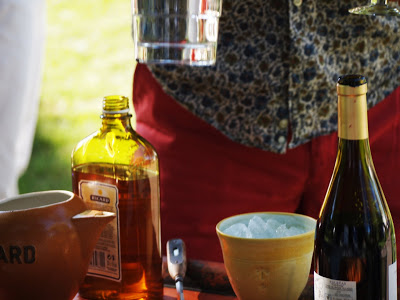 |
| Serving Pastis |


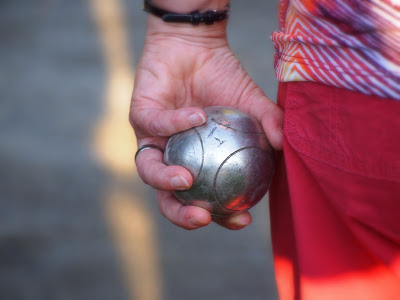





I also loved seeing the games of petanque AND drinking the pastis! Also, thanks for the info re the French language courses.
In the Maltese Islands a similar game is played on a long, earthen court…with similar players of the Mediterranean persuasion. Here it is called BOCCI. I was intrigued to notice the difference between the thrown object! In Malta the men throw a round heavy ball, but in Gozo, our charming neighboring farming island to the north of Malta, they throw a cylindrical 'ball'. It was explained to me that this game originated here from Sicily, where it is played with the cylindrical 'ball'…and indeed, Gozo is north of Malta, and therefore just a bit closer to Sicily than Malta, approximately a mere 60 miles away! I, too, love watching a game of Bocci, and have my favorite bar+restaurant in one of the Gozo villages, where there is a covered/roofed bocci court incorporated into the structure of the restaurant, so the old-timers can play in comfort all year 'round. : )
We, also, have spent many pleasant hours in Provence watching this game. Never quite understood what was going on, but now (I think) we do!
My Italian uncles always played bocci and, when we say the men playing pétanque in Saignon, it took me back. So sorry your lawn isn't up to the pétanque standards… but we are always happy to help with the pastis
Hello !
Oh que ça fait du bieng de revoir cet extrait d'anthologie, de Pagnol! Personne n'a jamais fait mieux : toute la mauvaise foi marseillaise est dans ces répliques-là…
Avoir les boules, c'est aussi une expression qui peut vouloir dire avoir peur, ou alors être tracassé, avoir du ressentiment…
J'espère qu'on jouera ensemble, à Lourmarin : je n'ai plus eu de boules en main depuis une dizaine d'année, je crois !!!
Tendresses vers vous,
Mumu & Pierrot
This comment has been removed by a blog administrator.
The Petague games remind me of the Bocci Ball games that were played in San Francisco's North Beach District. This was when North Beach was known for it's Beatniks.
The Beatnik era, circa 1948,preceded the Haight-Ashbury Hippies. This was an era of discontent. poets ran rampant. The evening hours brought them all out,some reading poetry and others hawking political views.
The only lasting pastime was the Bocci Ball. After reading your interesting account of the Petague games, I can see that it was played for many years before Bocci Ball. I have an idea that it was the Patis that kept them going !!!
loved this one especially since i have many photos of the men playing in paris and have to say their facial expressions were wonderfully charming — and one night on ile de la cite a group of young people playing at 10 pm whilst we were having dinner in one of the places there. as always, lovely writing.